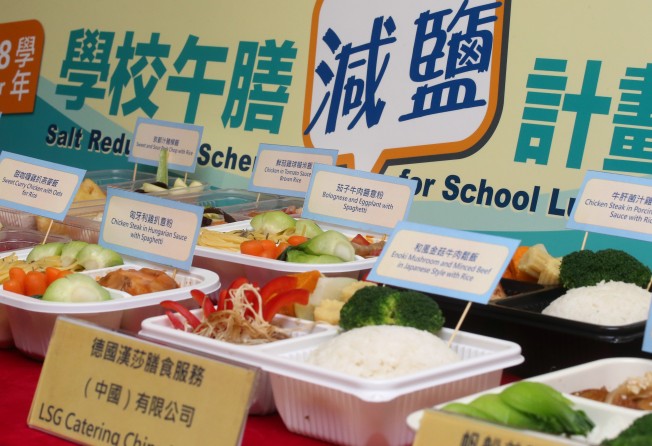
Drive begins to cut salt in Hong Kong pupils’ lunches by half in a decade
Health officials start with 13 suppliers serving 76 per cent of local primary schools

Health authorities have launched a voluntary drive to reduce salt levels in Hong Kong pupils’ lunches by half in a decade, starting with 13 suppliers on board to provide lower-sodium food to 76 per cent of primary schools.
Officials revealed on Thursday that since the start of the academic year this month, the 13 suppliers had already reduced sodium levels by nine per cent in meals served at 440 primary schools, exceeding the yearly target of five per cent, or a 50mg reduction per meal.
A government study in 2013 revealed that 99 per cent of school lunch samples contained an average of 950mg of salt per meal, exceeding the recommended intake of 500mg.

Primary school pupils only need a teaspoon, or 1,500mg of salt a day, according to the Department of Health.
Although participation in the low-salt drive will not be mandatory, the government hopes to cut down sodium levels in primary school lunches by 47 per cent by 2027.
A phased sodium reduction approach will help palates gradually adapt
Health authorities will also conduct a citywide test to evaluate nutrition levels in all primary school lunches early next year, which will also ascertain how much sodium levels have gone down since 2013.
Dr Anne Fung Yu-kei, the department’s assistant director for health promotion, said the drive would gradually improve children’s health in the long run.
“Excessive intake of sodium could lead to hypertension, or high blood pressure. It is also the major cause of cardiovascular diseases and stroke,” Fung said.
Condiments and seasonings such as chicken powder, soy sauce, ketchup and Worcester sauce are known to be major sources of high sodium levels in the Chinese diet.
Fung added it was important for schools not to label the lunchboxes as “reduced sodium” meals.
“We worry that children will form subjective connotations [if they are labelled]. A phased sodium reduction approach will help [pupils’] palates gradually adapt to the change in taste and increases their acceptance of less sodium in food,” she said.
A 47 per cent reduction target was in line with international standards, the department said. In the United States, a nationwide programme was introduced in 2012 to help schools reduce sodium in lunches by 53 per cent to 640mg by 2022.
There are no statistics on the prevalence of hypertension in children and adolescents, but government figures show an increasing rate of students with abnormal blood pressure levels being referred to hospitals.
Lunch suppliers have had to make alterations to recipes to meet the annual target, but they say that less salt does not necessarily mean bland meals.
In a pilot project last year, six suppliers sold more than 107,000 sodium-reduced lunchboxes to 306 primary schools, with only one complaint that the meal was tasteless.
Nicole Wong Ho-yan, a nutritionist at Danny Catering Service, said the company was able to meet the goal by reducing one tablespoon of sauce per lunchbox.
Another caterer said it used alternative seasonings in its marinade, such as ginger and herbs, which contained less salt.